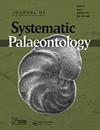Unravelling the identity of the platanistoid Notocetus vanbenedeni Moreno, 1892 (Cetacea, Odontoceti) from the early Miocene of Patagonia (Argentina)
IF 2.2
2区 地球科学
Q3 EVOLUTIONARY BIOLOGY
引用次数: 5
Abstract
Platanistoidea remains one of the most evolutionarily intriguing lineages of toothed whales (Odontoceti). The clade comprises mostly extinct species from the late Oligocene–early Miocene onward and a single extant riverine genus (Platanista). There is an ongoing debate as to the membership of Platanistoidea and the causes of their near extinction. In Patagonia (Argentina), the most abundant platanistoid recorded in the lower Miocene Gaiman Formation is Notocetus vanbenedeni, first described by Moreno in 1892 based on two individuals. The goal of the present contribution is to conduct an updated anatomical, palaeobiological and phylogenetic analyses of Notocetus vanbenedeni and hence contribute to an understanding of the evolutionary history of the Platanistoidea. Our analyses, including at least 26 individuals (12 undescribed), show that Notocetus vanbenedeni is a valid platanistoid taxon, recovered as part of a new clade. Among its most outstanding features, this taxon has an elevated dorsal tubercular supraorbital crest formed mainly by the frontal, the precursor of the pneumatized crest of the extant Platanista. Notocetus vanbenedeni also shows initial stages of the plesiomorphic bony connection between the earbones and skull as in Platanista, although the functional implications for hearing remain elusive. The nasal sac system, pterygoid sinus system and morphology of the earbones suggest that this species was able to hear high-frequency sounds and echolocate underwater, similar to extant odontocetes. Thus, Notocetus vanbenedeni presents a mosaic of features that suggest an intermediate platanistoid morphotype. Anatomical differences and phylogenetic analyses suggest that Peruvian specimens could not be referred to this species. The feeding apparatus of Notocetus vanbenedeni makes it the only combination suction-feeder recorded in the early Miocene of Patagonia and among the smallest odontocetes. Finally, the abundant records of Notocetus vanbenedeni in an inner shelf environment with freshwater influence suggest a possible early preference for such protected habitats.解开巴塔哥尼亚(阿根廷)中新世早期的北斑鲸(Cetacea,Odontoceti)的身份,1892年
Platanistoidea仍然是齿鲸(Odontoceti)进化上最有趣的谱系之一。该分支包括渐新世晚期至中新世早期的大部分已灭绝物种和一个现存的河流属(Platanista)。关于Platanistoidea的成员身份及其濒临灭绝的原因,目前正在进行辩论。在巴塔哥尼亚(阿根廷),中新世下盖曼组中记录的最丰富的platanistoid是Notocetus vanbenedeni,莫雷诺于1892年根据两个个体首次描述。本论文的目的是对范氏无角犀进行最新的解剖学、古生物学和系统发育分析,从而有助于了解扁蝶亚目的进化史。我们的分析,包括至少26个个体(12个未描述),表明范氏Notocetus vanbenedeni是一个有效的平台分类单元,作为一个新分支的一部分被恢复。在其最突出的特征中,该分类单元有一个升高的背结节眶上嵴,主要由额骨形成,额骨是现存Platanista气化嵴的前身。尽管对听力的功能影响仍然难以捉摸,但范氏Notocetus vanbenedeni也显示出与Platanista一样的耳骨和头骨之间的蛇颈骨连接的初始阶段。鼻腔系统、翼窦系统和耳骨的形态表明,该物种能够在水下听到高频声音并进行回声定位,类似于现存的牙缝。因此,范氏Notocetus vanbenedeni呈现出一系列特征,表明其为中等平台状形态类型。解剖学差异和系统发育分析表明,秘鲁标本不能被认为是该物种。vanbenedeni Notocetus的喂食器使其成为巴塔哥尼亚中新世早期记录的唯一一种组合抽吸喂食器,也是最小的牙冠之一。最后,在受淡水影响的内陆架环境中,范氏无角犀的丰富记录表明,早期可能更喜欢这种受保护的栖息地。
本文章由计算机程序翻译,如有差异,请以英文原文为准。
求助全文
约1分钟内获得全文
求助全文
来源期刊
CiteScore
5.30
自引率
7.70%
发文量
31
审稿时长
>12 weeks
期刊介绍:
The Journal of Systematic Palaeontology publishes papers that provide novel and impactful results in phylogenetics and systematics and that use these results in ways that significantly advance rigorous analyses of palaeogeography, palaeobiology, functional morphology, palaeoecology or biostratigraphy. Papers dealing with theoretical issues or molecular phylogenetics are also considered if they are of relevance to palaeo-systematists. Contributions that include substantial anatomical descriptions, descriptions of new taxa or taxonomic revisions are welcome, but must also include a substantial systematics component, such as a new phylogeny or a revised higher-level classification. Papers dealing primarily with alpha-taxonomic descriptions, the presentation of new faunal/floristic records or minor revisions to species- or genus-level classifications do not fall within the remit of the journal.

 求助内容:
求助内容: 应助结果提醒方式:
应助结果提醒方式:


